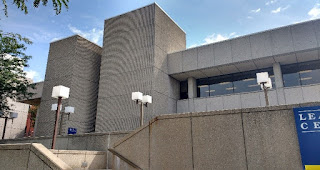Brutalist Architecture in Grand Rapids
 |
| Michigan Government building, Grand Rapids |
If you’ve ever been to a government
office, city hall, or other administrative building there’s a good chance
you’ve experienced brutalist architecture. Created in the 1960’s as traditional
architecture norms were being questioned, the term “brutalism” originates from
the French term meaning “raw”. This building style often features exposed
concrete, limited amounts of windows, and a cult-like focus on symmetry.
Brutalism draws a lot of flak for what it represents: a removal of aesthetics
from architecture and an emphasis on function, but regardless of public
perception, brutalism is still a major architecture style and great examples can
be seen right here in Grand Rapids.
 |
| Map of downtown Grand Rapids (shaded portion indicates area affected by 1960's urban renewal) |
“Out with the old and in with the new”
seemed to be the rallying cry of Grand Rapids in the 1960’s as the city began urban
renewal projects to “modernize” the downtown area. The area most affected by
this process was north of Lyon Street, which, by no coincidence, is where you
can find the highest concentration of brutalist architecture. The old city hall
building, built in 1892, was demolished and replaced with surface
parking on Ottawa Street. Factories and other businesses in the area were
bulldozed and new city administrative offices replaced them.
 |
| Michigan State Government building, Grand Rapids |
A prime example of brutalism within this
area is the Michigan State Government building at 385 Ottawa Street NE. Large
and imposing, it looks like a table carved from a single block of stone. The
immense scale and garish lack of windows seems to contribute to the “concrete
jungle look” that many architects now avoid, but efforts to incorporate trees
along Michigan Street has improved the street appeal.
 |
| Cook Hall, Grand Rapids |
 |
| Gerald Ford Recreation Center, Grand Rapids |
Grand Rapids is home to many colleges, with a
wide array of architecture seen on each campus. One college however embraced
brutalism and dialed it up to eleven. Undergoing expansion in the seventies,
Grand Rapids Community College built some of the city’s finest examples
of stone-cold minimalist architecture. Cook Hall, a five-story monolith of a
building, stands at the corner of Lyon Street and Bostwick Avenue. The Gerald Ford
Recreation Center is nearby as well, and besides “The Legend of Grand Rapids”,
a sixty-foot long marble frieze spanning one side, there are no interruptions
in the massive concrete walls of the building.
 |
| Library and Learning Commons, Grand Rapids |
A
block south of the Ford Recreation Center is the Library and Learning Commons,
a large building that seems to cling to the ground, with a low-hanging roof and
tall concrete columns. Built in 1973, it exhibits many brutalist qualities,
such as the cold, “no-nonsense” exterior and exposed concrete on the interior
stairways. As uninviting as it seems, it offers many pleasant qualities
however, such as skylights on the second floor and an incorporation of trees
around the building.
 |
| Library and Learning Commons, Grand Rapids |
There is plenty of interesting
architecture to be found in Grand Rapids, and the city’s history of urban
development through the 1960’s and 1970’s makes it a perfect showcase of the
shift towards brutalism that was happening at the time. Whether it’s positive
or negative is still open to discussion, but one thing is for certain, Grand
Rapids has an abundance of these buildings we can either scorn or admire.
The photo you have labeled as the state government building is the federal building.
ReplyDeleteThe drawing you show below is correctly labeled as the state building.
Possibly the best (or worst) example of brutalist style is the AT&T building on Hall St. (it’s at Madison or Jefferson).
Clearly built to be immune from urban unrest. It makes brick into a new fortress of brutalist style.